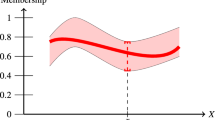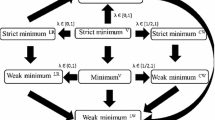Abstract
A definition of the degree to which a normalized convex fuzzy number is greater or equal to another fuzzy number is proposed which satisfies the Ferrer’s condition and consequently the max-min transitivity.
It is based on the compensation of areas determined by the membership functions.
Using the fuzzy preference relation, one can handle inequality constraints, the related conditions being free from any parametrization.
The particular case of L — R fuzzy numbers is considered and its is proved that in this case, comparison of areas is reduced to the comparison of upper and lower bounds of α-cuts.
Two examples related to comparison of fuzzy numbers and fuzzy optimization are also presented.
Access this chapter
Tax calculation will be finalised at checkout
Purchases are for personal use only
Preview
Unable to display preview. Download preview PDF.
Similar content being viewed by others
References
Baldwin, F.F. and Guild, N.C.F. (1979) Comparison of fuzzy sets on the same decision space’, Fuzzy Sets and Systems 2, 213–231.
Dubois, D. and Pralle, H. (1980) Systems of linear fuzzy constraints’, Fuzzy Sets and Systems 3, 37–48.
Nakamura, I (1986) Preference relations on a set of fuzzy utilities’, Fuzzy Sets and Systems 20, 147–162.
Ramik, J. and Rimanek, J. (1985) Inequality relation between fuzzy numbers and its use in fuzzy optimization’, Fuzzy Sets and Systems 16, 123–138.
Roubens, M. (1986) Comparison of flat fuzzy numbers’, in N. Bandler and A. Kandel (eds.), Proceedings of NAFIPS’86, pp. 462–476.
Roubens, M. and Vincke, P. (1988) Fuzzy possibility graphs and their application to ranking fuzzy numbers’. in J. Kacprzyk and M. Roubens (eds.). Non-conventional Preference Relations in Decision Making, Springer-Verlag, pp.119128.
Slowinski, R. (1986) A multicriteria fuzzy linear programming method for supply system development planning’, Fuzzy Sets and Systems 19, 217–237.
Author information
Authors and Affiliations
Editor information
Editors and Affiliations
Rights and permissions
Copyright information
© 1990 Kluwer Academic Publishers
About this chapter
Cite this chapter
Roubens, M. (1990). Inequality Constraints between Fuzzy Numbers and Their Use in Mathematical Programming. In: Slowinski, R., Teghem, J. (eds) Stochastic Versus Fuzzy Approaches to Multiobjective Mathematical Programming under Uncertainty. Theory and Decision Library, vol 6. Springer, Dordrecht. https://doi.org/10.1007/978-94-009-2111-5_16
Download citation
DOI: https://doi.org/10.1007/978-94-009-2111-5_16
Publisher Name: Springer, Dordrecht
Print ISBN: 978-94-010-7449-0
Online ISBN: 978-94-009-2111-5
eBook Packages: Springer Book Archive




